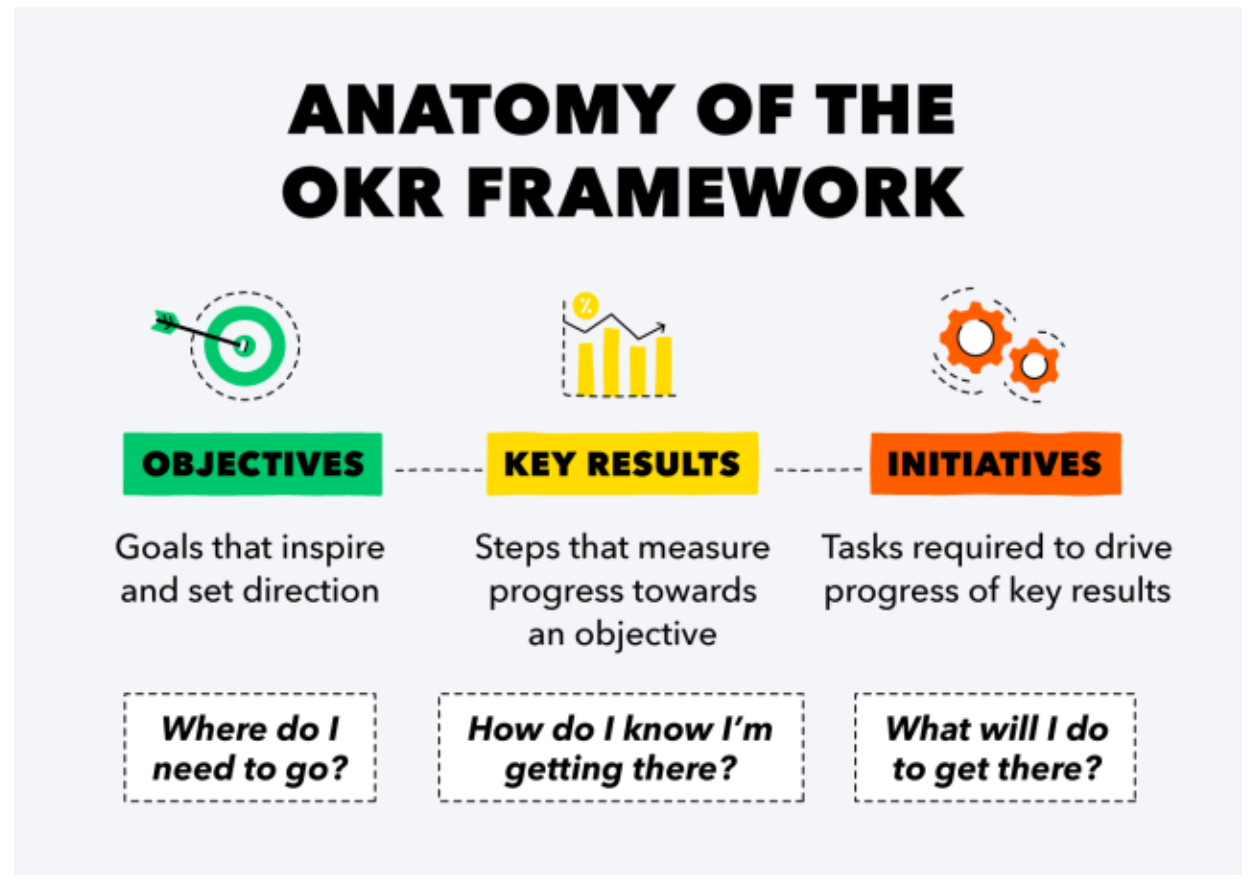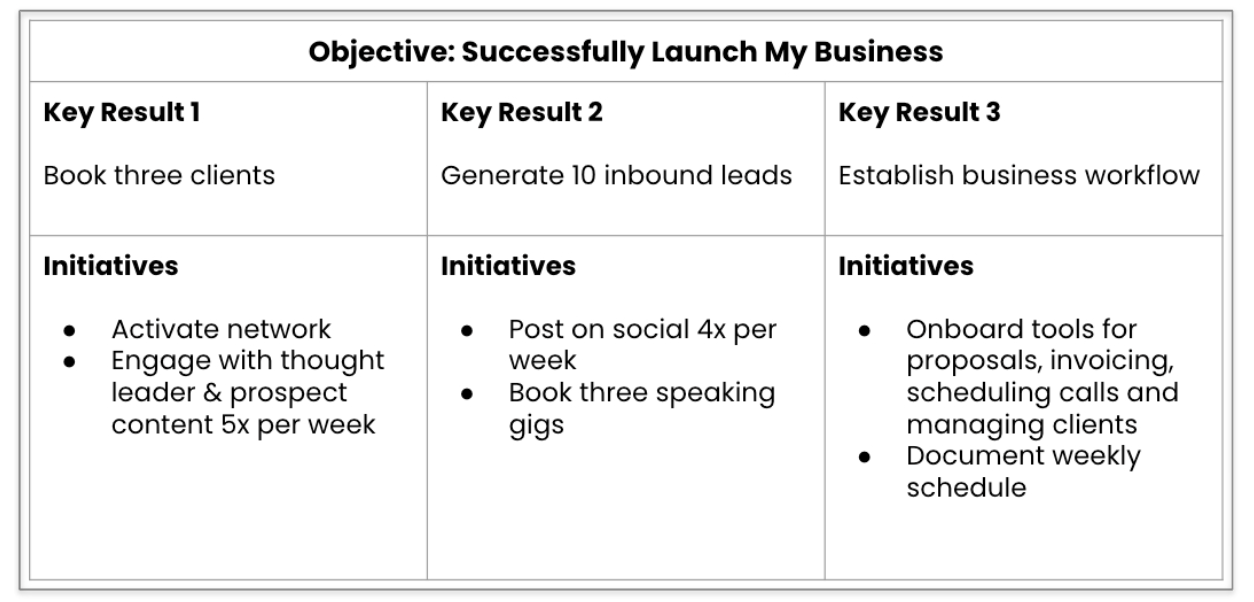Avoid confusion, focus on impact and increase your revenue with this simple four step process

You may have heard the phrase “A goal without a plan is just a wish.” And while that may be directionally true, it doesn’t provide any pointers on how to actually create and take action on your goals.
We’re going to solve that problem now. And if you follow these steps you’ll be able to create – and achieve – meaningful goals that allow you to live in the vision you have for yourself and your business.
I’m going to breakdown:
- How to determine the most important goals you can take to grow your business
- The measurable steps you should take to achieve those goals.
- How to plan your workday and avoid distractions
Let’s get started.
Heads up. If you’d prefer to listen instead of reading, I cover this same process on the latest episode of my podcast, Launch Your Business.
The one question to help you set meaningful goals
The first step is to establish your business goals. I discovered a simple but effective way to do so while reading the book The One Thing by Gary Keller and Jay Papasan. To create an impactful goal you’re going to ask yourself what they call the focusing question.
Here it is “What’s the ONE THING I can do, such that by doing it, everything else will be easier or unnecessary?”
And remember, we’re thinking about this from the lens of your business. Of course, your answer will vary based on where you’re at in your business. It could be to make $100k next quarter or start offering a new service. It could even be just to have a successful launch for your business.
Either way, accomplishing that one thing should make everything else easier or unnecessary.
And when I think about my one thing for the upcoming quarter it’s to book more speaking gigs. I’ll explain why in case it helps you discover your one thing as well.
First of all, speaking can pay very well. In one hour I can make more than I might make in one month working with an individual client. Speaking also allows me to help more people at scale since there are several individuals listening to my content at once. And, I always stick around to answer their questions since I learn by helping others. Lastly, some of those people listening may end up hiring me to help them on an individual level as well.
So I get to make money, help people, learn something new and land more clients. That’s a pretty good way to make everything else easier or unnecessary.
Action item: Jot down your one thing. I recommend focusing on something you can accomplish in about 90 days.
Document your Objectives and Key Results
Next, let’s put more structure around your goals. And to do that we’re going to use OKRs which stands for Objectives and Key Results. This is a goal-setting methodology used by teams and individuals to set challenging, ambitious goals with measurable results.
This is the approach that I use for my business and help all my clients develop as well. As a heads up, these goals must include a defined time period, usually one quarter.
I’ll walk through the framework momentarily but take a look at the image below first.

You typically start with one objective. This will most likely be the one thing that you came up with earlier. And in this case we’ll just say it’s to have a successful launch for your business.
But how do you measure what “a successful launch” even means? That’s why you need key results, the steps that measure progress towards your objective. So, one key result could be booking three clients. This is easy to measure and clearly aligns with your objective.
Another could be generating 10 inbound leads. I’m adding this one because it shows you have a process for attracting prospects, which is vital to your long term success. The last one I’ll add is establishing your business workflow. The tools, apps and routines you use to generate revenue without burning out.
So in this case if our objective is to launch a successful business we want to do the following:
- Book three clients
- Generate 10 inbound leads
- Establish our business workflow

From there you must identify specific initiatives that are required to accomplish your key results. And we’ll use generating 10 inbound leads as an example. What will you do to generate these leads? Those are your initiatives. And there are a few ways to do it, but let’s get specific.
The first initiative will be posting on LinkedIn four times a week. This will give you an opportunity to show your personality and perspective. And after you write a helpful post, encourage people to message you if they have any questions. This is how you’ll generate leads from posting.
Another initiative – and one of my favorites – booking three speaking gigs. I should note, it doesn’t matter how big the audience is, your goal is to get in front of people and share your knowledge. And similar to posting on social media, you’ll make it clear they can reach out to you with any questions. This is one of the easiest ways to get leads and eventually you’ll even get paid for it. So essentially, you’re getting paid to do lead generation.
And that’s the OKR framework. A simple way to plan and achieve meaningful goals.
Action item: Plan your OKRs for the upcoming quarter. Share them with a friend for feedback and accountability.
Determine what additional resources you need
Once you develop your OKRs, ask yourself a very important question, “What am I missing”? Based on what you need to accomplish, what’s missing? Where are you stuck given your current tools, knowledge or time constraints?
For example if your goal was to book three speaking gigs, and you don’t have a speaking topic prepared, that’s what you’re missing!
You may also discover you’re missing a script to pitch your topic and a list of organizations to contact as well. Or, maybe you have no clue how to do any of this stuff, which means you’re missing the guidance and structure needed to make it all happen.
Either way, you now have a clear understanding of the resources you’ll need to achieve your objectives and can go about creating or acquiring them.
Action item: Jot down the additional resources or training you’ll need to hit your goals.
Develop your missing resources and partnerships
So now you’ve identified your objectives and the critical missing pieces needed to implement them. The next step? Ask for help. If you know of specific people in your network who can either help you directly or perhaps recommend a resource, start there.
If not, consider sharing your request as a social media post. This will allow you to passively promote your business and potentially get some assistance at the same time.
For example, you could say something along the lines of the following:
“Can you help me out?
As you may know I’ve recently launched my own business.
In short, I help eCommerce companies grow and monetize their email list.
One of my goals for this quarter is to land three speaking gigs and I’m looking for someone to help me write pitches!
Does anyone have recommendations?
I appreciate your help!”
Of course, you can tweak it however you see fit. The main goal here is to save time and reduce uncertainty by asking your network for help.
As an added benefit, you may even attract some leads and referrals from people who were unaware of your services
Action item: Ask your network for help and perform research to secure additional resoruces.
Go from planning to execution
Let’s do a quick recap here before moving forward.
- Plan your OKRs
- Identify what’s missing
- Ask your network for help
And here’s the last part, which is probably the most important, taking action on your goals. And that all starts with planning how to spend your time in the most effective way possible. Again, that focusing question we talked about earlier comes in handy. So as you’re planning your quarter I want you to think to yourself
“What’s the one thing I can do this quarter, such that by doing it, everything else will be easier or unnecessary?
Then, break it down on a monthly level.
“Based on my goal this quarter, what’s the one thing I can do this month?”
Then, break it down on a weekly level.
“Based on goal this month, what’s the one thing I can do this week?”
And you’ll continue.
What’s the one thing I can do today?
What’s the one thing I can do right now?
And whenever you find yourself not doing that one thing, stop and get back on track!
I use this process all the time and I’ll actually stop in the middle of a task if I realize it’s not the most important thing for me to do. It takes discipline, but it will provide you with the clarity, confidence and commitment needed to achieve your goals.
So, to recap
- Plan your OKRs
- Identify what’s missing
- Ask your network for help
- As you’re going throughout your day, focus on the one thing
What’s next?
Block off one hour to complete these steps. And I highly suggest enlisting an accountability partner. You’ll then have the clarity and support needed to meet and exceed your goals.
And if you’d like help growing your professional service business consider joining my video course, The Solopreneur’s Shortcut. Through a combination of videos, worksheets and templates you’ll discover how to package, price and promote your services so you can attract high-paying clients.
Either way, I wish you the best of luck and if you have any questions feel free to contact me on LinkedIn or Instagram.
This article was written by Terry Rice, and originally appeared on Entrepreneur.com.




